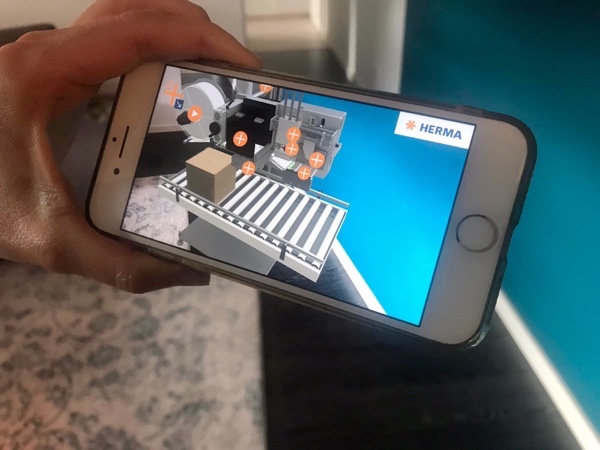Packaging
Now also labelling of variable carton heights

Monday 11. May 2020 - With what is probably the first linerless labelling system to meet the demanding requirements of shipping labels, HERMA caused a sensation last year. Now the self-adhesive specialist is showing for the first time how even variably fed and therefore differently sized shipping cartons can be labelled on top in any order: The HERMA InNo-Liner system will be available from October 2020 with sensor-controlled variable labelling height. This would already have been on show live at the Interpack 2020.
But thanks to a new app and augmented reality, anyone interested can now project the system into their desired environment, at least using a smartphone and tablet, and then experience it in action. The app “InNo-Liner AR” is available free of charge for Apple and Android. “The variable labelling height was the missing development component for series production of the system”, says Martin Kühl, who heads HERMA’s Labelling Machines Division. “This also incorporates the knowledge we have gained since last autumn from the first test runs in the context of specific customer projects”. The HERMA InNo-Liner System was initially used there with modules designed for side labelling. “Even with this system we were able to demonstrate convincingly that the system was the right choice in terms of speed, process reliability and
-stability meets the requirements for use in logistics centres,” says Martin Kühl. In the series model now introduced, the label that is not yet adhesive is transferred to a vacuum suction plate equipped with a sensor for the carton height and a linear unit. First, a purely water-based activation unit moves under the label at right angles to the running direction and activates the adhesive with a micro-fine, extremely even spray mist. The linear unit then automatically moves the vacuum suction plate with the activated label to the labelling height required for the respective pack. The desired extremely high adhesion of the labels results from the perfect interaction of the activation unit with the patented 82S multi-layer adhesive. It is not without reason that the HERMA InNo-Liner System is a joint development of all three business units of the company: adhesive material, labels and labelling machines. “Being able to use this bundled know-how was and is essential for the success of this project”, emphasizes HERMA managing director Dr. Thomas Baumgärtner.
Minimal water consumption
The InNo-Liner system uses demineralised water, i.e. water in its purest form, as the activation medium for the initially non-adhesive pressure-sensitive adhesive. “This ensures consistently high process quality, regardless of the water’s degree of hardness, which naturally fluctuates depending on location,” explains Dr. Baumgärtner. Water consumption is minimal, also because unused water is filtered and returned to the system. The activation unit can also be cleaned as required. Apart from changing the label roll, hardly any manual intervention is required. The variable data can be printed either by thermal transfer or direct thermal printing. In addition, the labels can be pre-printed in colour using conventional printing methods.
Since the first presentation of the system and the presentation of the German Packaging Award in autumn 2019, HERMA has already been overrun with enquiries. “One reason for this is, of course, the easy to understand and simple concept. It requires no solvents, no heat and no other activating agents with any undesirable side effects. It is also as cost-effective as a conventional self-adhesive label,” explains Dr. Baumgärtner. “On the other hand, the search for truly sustainable packaging solutions is generating an ever-increasing pull effect.” The HERMA InNo-Liner system, which was specially developed for shipping labels, saves thousands of tonnes of siliconised paper liner material and its subsequent disposal – “an unbeatable argument in terms of increased sustainability”, as Dr. Baumgärtner emphasises. “Especially when you consider how the global parcel volume will develop.” Experts predict that the sheer volume of cartons shipped will almost double by 2025 – to around 200 billion units worldwide by then.
